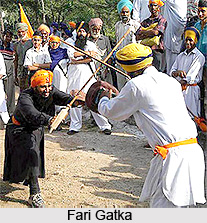 Fari Gatka is an ancient Indian fencing-combat form that incorporates the use of swords and shields. India is home to a variety of fighting and combat techniques. India deeply influenced the development of various modern martial arts, particularly within the countries that have been influenced by Indian culture and religion and one such game is Fari Gatka. It is a bladeless armed combat technique developed by the Sikhs of Punjab, in North-Western India. It is practiced like sword-fighting, but with wooden sticks and leather shields. This martial art was conceived as an offensive, as well as defensive combat form, which focuses on developing the physical state along with strengthening the mental and spiritual aspects as well.
Fari Gatka is an ancient Indian fencing-combat form that incorporates the use of swords and shields. India is home to a variety of fighting and combat techniques. India deeply influenced the development of various modern martial arts, particularly within the countries that have been influenced by Indian culture and religion and one such game is Fari Gatka. It is a bladeless armed combat technique developed by the Sikhs of Punjab, in North-Western India. It is practiced like sword-fighting, but with wooden sticks and leather shields. This martial art was conceived as an offensive, as well as defensive combat form, which focuses on developing the physical state along with strengthening the mental and spiritual aspects as well.History of Fari Gatka
History says that this martial art dates back to the Mughal era. It is said that initially it was practiced by the Sikh inhabitants of Punjab to protect themselves from Mughal invasion. It is also believed that a form of this art involving the use of sword and shield was practiced by Akbar.
Practice of Fari Gatka
It is practiced with a cane stick which is used as a Gatka or sword along with a small leather shield called Fari. The word Gatka is derived from the Sanskrit word "Gada", meaning Mace. The sword is usually around 3 foot, where as the shield is 9 inches in diameter. The Fari is made with sturdy leather and weighs around 1lbs. Fari Gatka is practiced in a 20 foot quadrangle arena. The sport involves the use of weapons by both hands, for it is believed that proper co-ordination of the two sides of the body is necessary for balanced development. The fighters could score points only when their swords would come in contact with vital pressure points on the opponent's body. The match ends when one of the participants has received 5 strikes in the body.
For more, visit the link below: